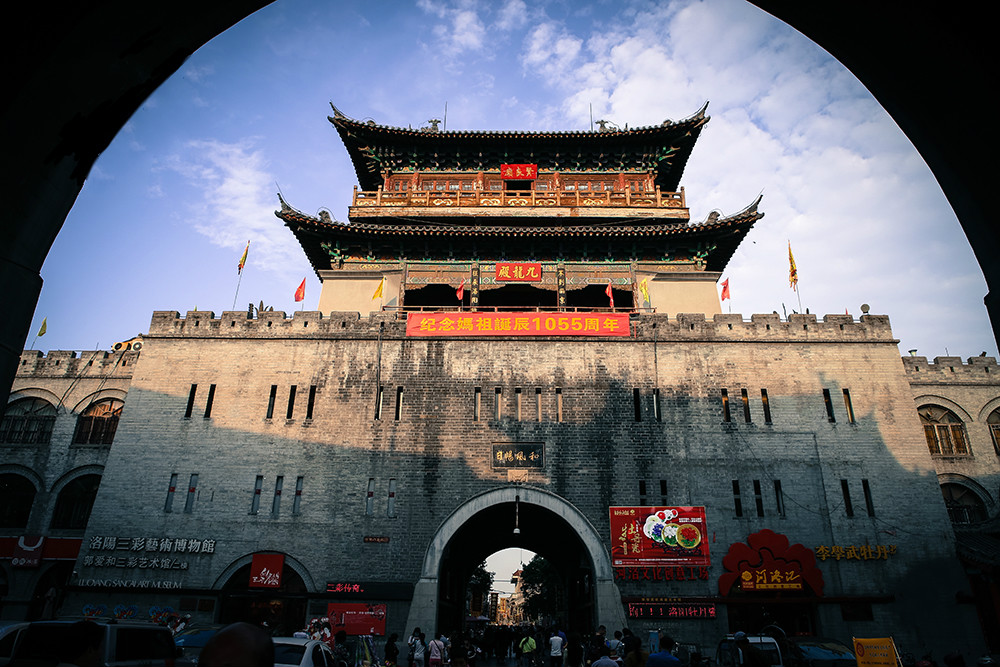Luoyang: An ancient template for Chinese capital cities

Lijing Gate, established in the Sui Dynasty, is the western gate of ancient Luoyang city. This magnificent city gate reveals the prosperity and spectacular view of Luoyang in former days.
The ancient capital Luoyang, Henan Province, is often regarded as one of China’s most well-designed capital cities. With 4,000 years of urban development history and 1,500 years of history as a capital, Luoyang occupies an important place in the history of Chinese urbanization.
Luoyang is not only a rich and fertile land with plenty of water and lush grass, but also a significant strategic area surrounded by mountains and water for protection. Gu Zuyu, a geographer in the Qing Dynasty, once said of the city, “Mountains and water embrace this place, and its geographical advantages are unequaled in the world.” This advantageous location was the prime reason why this site was chosen as a capital.
Zhu Shiguang, a professor of Shaanxi Normal University, has indicated that ancient Chinese utilized natural conditions for military defense, and founded the capital city based on geography. They built the city following the rhythm of natural mountain ranges and river systems to integrate defense functions, which became the guiding concept for ancient Chinese urban planning.
Other than the advantages of the geographical environment, the site selection of Luoyang reflects that ancient Chinese hold the principle of “founding the capital in the center of the world,” Zhu said. “From the perspective of the ancients, Luoyang is located in the center of the earth (China). So founding the capital in the center of the ruling regions made it convenient for the ruler to carry out executive orders, levy taxes, and to control and indoctrinate subjects, which can not only strengthen their rule, but also convey the ancients’ idea of bringing the whole world under one’s domination. ”
In 1963, a bronze item dated back to the reign of King Chengwang in the Western Zhou Dynasty was excavated in Baoji City, Shaanxi Province. On the bronze item, there is an inscription with only 122 Chinese characters which clearly records the significant historical event of King Chengwang building Luoyi (modern Luoyang). One sentence of the inscription, literally meaning “I want to live in the center of the world,” was the earliest written record about the term “zhongguo,” the most common Chinese name for China. The term originated from the belief that the Zhou Dynasty was the “center of civilization” or “center of the world.” Xu Jinxing, a research fellow at Henan Provincial Research Institute of Culture and History, indicated that this finding is in line with correspondence in the Book of Documents, which reveals that the area where Luoyang is located was the primary location of “zhongguo.” Although dynasties changed and the idea about where the center of the world changed, the principle of founding the capital in the middle has exerted a far-reaching influence on the ancient construction of capital cities since its birth from the Western Zhou Dynasty.
Since the 1950s, archaeologists have discovered several capital sites of various dynasties in the area of Luoyang, such as the Erlitou Site, Yanshi City of the Shang Dynasty, the Capital Site of the Eastern Zhou Dynasty, Capital Site of the Han and Wei dynasties and Luoyang City in the Sui and Tang dynasties. Through archaeological excavations, historical restoration and documents, more and more abundant information has emerged about the development and construction of ancient Chinese capital cities and their societies.
Academia always regarded the studies of Luoyang as a priority. Since the 1950s, especially since the middle of the 1980s, a number of excavated capital sites have enriched research of this ancient city.
Zhang Jie and Zhang Qingli are reporters at the Chinese Social Sciences Today.
